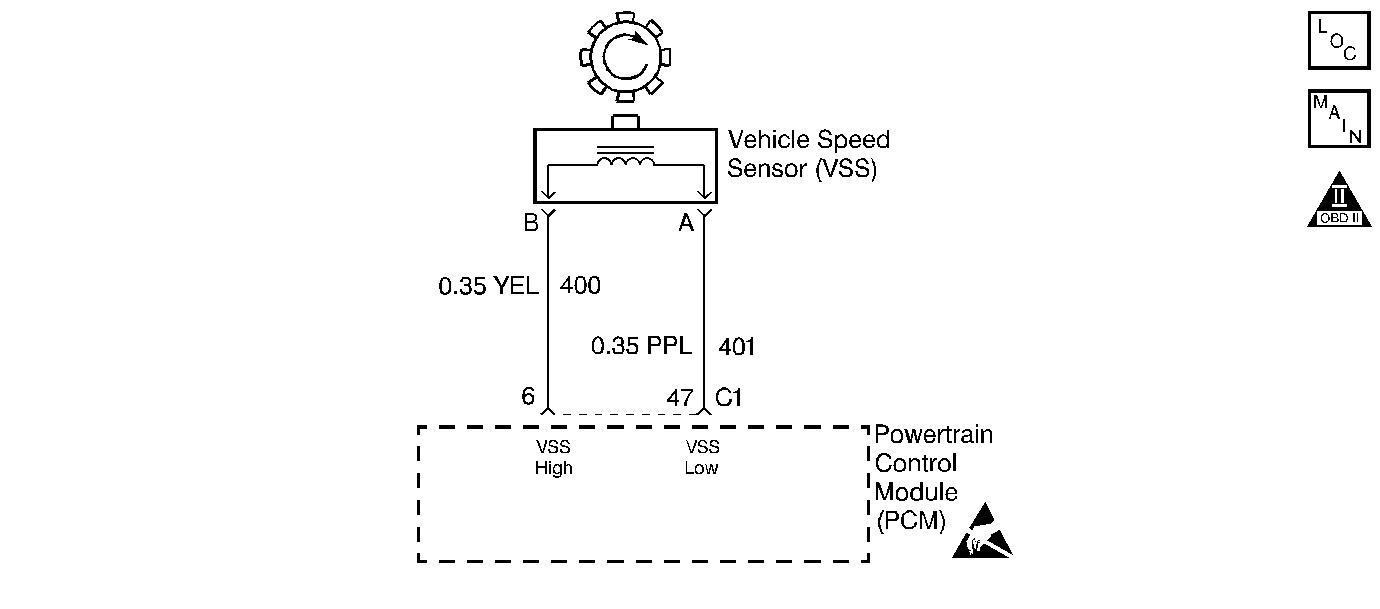
Circuit Description
The Vehicle Speed Sensor (VSS) is a Permanent Magnet (PM) generator attached to the transmission case. The final drive assembly has a toothed wheel (VSS rotor). As the final drive assembly rotates, an AC voltage is induced and transmitted to the Powertrain Control Module (PCM).
The PCM converts the AC voltage into a digital signal. The PCM uses vehicle speed to determine shift timing, TCC apply and release, and the gear ratio calculations. VSS voltage will vary from 0.5 volts AC at 100 RPM to more than 100 volts AC at 6000 RPM. VSS resistance value is 981-1864 ohms.
If the PCM detects a large change in vehicle speed, then DTC P0503 sets. DTC P0503 is a Type B DTC.
Conditions for Setting the DTC
| • | The transmission is not in Park or Neutral. |
| • | The gear select lever change is more than 6 seconds. |
| • | The engine speed is more than 500 RPM. |
| • | Not in fuel shut off. |
| • | No output speed rise greater than 1000 RPM in 2 seconds. |
| • | The output speed drops more than 1500 RPM in 2 seconds. |
Action Taken When the DTC Sets
| • | The PCM illuminates the Malfunction Indicator Lamp (MIL) after 2 consecutive ignition cycles with a failure reported. |
| • | The PCM disables shift adapts. |
| • | The PCM commands maximum line pressure. |
| • | The PCM calculates vehicle speed from the Automatic Transmission Input Speed Sensor (A/T ISS) and from the commanded gear. |
Conditions for Clearing the MIL/DTC
| • | The PCM turns OFF the MIL after three consecutive ignition cycles without a failure reported. |
| • | A scan tool can clear the DTC from the PCM history. The PCM clears the DTC from the PCM history if the vehicle completes 40 warm-up cycles without a failure reported. |
| • | The PCM cancels the DTC default actions when the fault no longer exists and the ignition is OFF long enough in order to power down the PCM. |
Diagnostic Aids
| • | Inspect the wiring for poor electrical connections at the PCM. Inspect the wiring for poor electrical connections at the VSS 2-way connector. Look for the following problems: |
| - | A bent terminal |
| - | A backed out terminal |
| - | A damaged terminal |
| - | Poor terminal tension |
| - | A chafed wire |
| • | Inspect the engine wiring harness for pinched wires which may cause an intermittent. When diagnosing for an intermittent short or open, massage the wiring harness while watching the test equipment for a change. |
| • | Check for an Electromagnetic Interference (EMI) induced on circuits 400 and 401 by a misrouted wiring harness along the spark plug wires. |
| • | Ensure that the VSS is tightened securely into the transmission case extension. |
| • | Too much runout in the final drive carrier may set DTC P0503. If you cannot find a problem with the VSS or its circuitry, replace the final drive carrier. |
Test Description
The numbers below refer to the step numbers on the diagnostic table.
-
This step checks for a vehicle speed signal. It is important to record freeze frame or failure records information before proceeding further.
-
Important: Place the gear select lever into the Neutral position before rotating the wheel.
This step checks for an AC voltage at the PCM.
-
This step performs a resistance check on circuits 400 and 401 from the PCM to the VSS. Circuit 400 and Circuit 401 must be checked for an open.
Step | Action | Value(s) | Yes | No | ||||||||||||
|---|---|---|---|---|---|---|---|---|---|---|---|---|---|---|---|---|
1 | Was the Powertrain On-Board Diagnostic (OBD) System Check performed? | -- | Go to A Powertrain On Board Diagnostic (OBD) System Check | |||||||||||||
Important: Before clearing the DTCs, use the scan tool in order to record the Freeze Frame and Failure Records for reference. The Clear Info function will erase the data. Notice: Support the lower control arms in the normal horizontal position in order to avoid damage to the drive axles. Do not operate the vehicle in gear with the wheels hanging down at full travel. With the drive wheels rotating, does the Trans OSS RPM increase when the wheel speed increases? | -- | Go to Diagnostic Aids | ||||||||||||||
Is the voltage greater than the specified value? | 0.5 V | |||||||||||||||
4 | Connect an J 39200 Digital Multimeter from terminal 6 to terminal 47 of the PCM connector. Does the J 39200 Digital Multimeter display a value greater than the specified value? | 1864 ohms | ||||||||||||||
Inspect circuit 400 or circuit 401 for an open. Refer to Troubleshooting Procedures, Section 8. Did you find and correct the condition? | -- | |||||||||||||||
6 | Does the J 39200 Digital Multimeter display a value within the specified range? | 981-1864 ohms | ||||||||||||||
7 | Inspect circuit 400 or circuit 401 for a short to ground or a short together. Refer to Troubleshooting Procedures, Section 8. Did you find and correct the condition? | -- | ||||||||||||||
8 |
Does the J 39200 Digital Multimeter display a value within the specified range? | 981-1864 ohms | ||||||||||||||
9 | Replace the Vehicle Speed Sensor. Refer to VSS Replacement/Unit Repair. Is the replacement complete? | -- | -- | |||||||||||||
10 |
Did you find and correct a condition? | -- | ||||||||||||||
11 | Replace the PCM. Refer to PCM Replacement/Programming , Section 6. Is the replacement complete? | -- | -- | |||||||||||||
12 | In order to verify your repair, perform the following procedure:
Has the test run and passed? | -- | System OK |
